Monster Codex
| Grassland |
Desert |
Grassland monsters
Forest Beast
Morphs
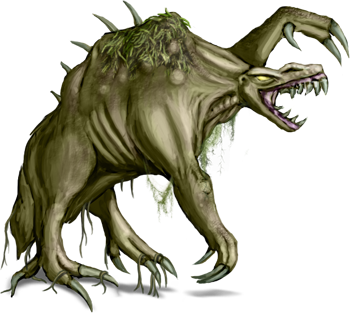 Normal
Normal
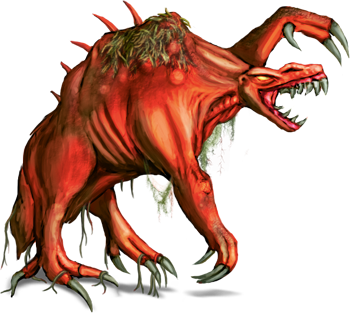 Guardian
Guardian
Species-specific abilities
None
The forest is thicker here than you think you've ever seen, so much so that the sun barely feeds through the criss-crossed branches over your head. Moss grows on every available surface, creeping over boulders and fallen trees, hanging like curtains from branches. Ferns strain upwards for any sign of light. You wonder if it's somehow gotten later than you originally thought, and perhaps the sun has vanished for the day. As it becomes more and more difficult for your lantern to penetrate the darkness, you make the decision to double back. Funny, you don't remember that boulder being in the way. As you step over it, there is a low rumbling sound and the earth below you begins to shift. A single eye glitters in the mass, and you realize that this moss-ridden, bulky thing is alive; and judging by the row of yellowed teeth practically glowing in the dark, it's hungry.
Forest Beasts perhaps have on of the most tragic stories of the creatures in Europa. In the darker, damper area of the wild, parasites have evolved. Resembling leeches in their worm like shape, they attach with a circular mouth packed with sharp, needle-thin teeth and release the virus. If the animal goes untreated for forty-eight hours, the virus incubates, transforming its host over the course of several stages. In the early stage, the newly infected becomes timid and secretive. Highly sensitive to light as well as many, many sounds, the infected goes into hiding deep in caves or forests and out of the reach of the sun. Shortly after the infected begins to bloat. New muscles form and bulk up, and bones began to grow and elongate to support the new mass. While they increase in size, their nervous system and intellectual abilities begin to reduce rapidly, making them less sensitive to pain if not oblivious.
When this transformation completes, taking less than seventy-two hours, the new form will stagger from its den in search of food. Driven by aggression and hunger, encounters with the monster are typically deadly. These brutal creatures are without fear and known to attack creatures well over their size. Featuring massive, bony heads and broad hands with huge claws, they're tanks in the world of carnivores. Requiring massive amounts of food to support their bodies, their mind focuses on one thing: Food.
If one comes in contact with a Forest Beast, the first and foremost thought should be to escape, and as quickly as possible. Contamination by one is fairly easy, spread through both saliva and blood as well as through open wounds. The virus spreads easily, thriving on the skin of forest beasts.
After returning from heavily wooded areas and swamps, pet owners should check over their pets thoroughly for signs of the virus. Due to how easily the infection can be spread, hospitals provide the anti-virus serum free of charge! It is highly suggested to visit your local hospital after roaming the forests, as tests are fairly cheap and easily completed. If you run across a Forest Beast in your travels and fail to defeat it, alert your local authorities.
Cygnon
Morphs
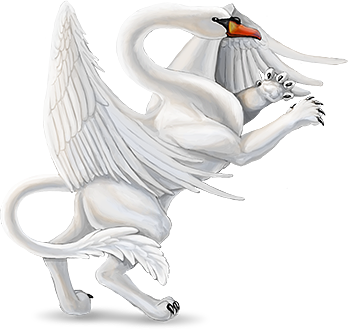 Normal
Normal
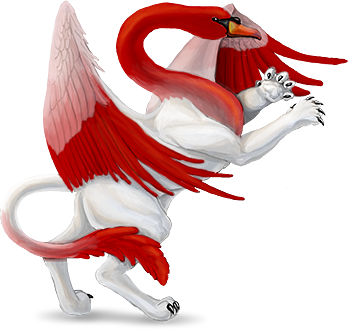 Guardian
Guardian
Species-specific abilities
- Shriek
- Berserker
- Second breath
Ahead, there is the sound of rushing water. Relieved at the thought of getting a drink, you wander past the treeline to the open field but come to a stop as you approach the banks. From a distance, you can see the head of a swan dipping into the water and plucking at reeds. Despite your thirst, you hesitate. Swans are known for their territorial behavior and general aggression, and while you're fairly sure you can beat back a swan, you're not sure if a drink of water is worth the inevitable bruises.
Carefully, you move forward, edging around it to further downstream. Something about the beast is off. It's much too large, and it's body appears submerged. Is the water that shallow? No, that's not right either. A glance down proves it, you can't even see the bottom from where you stand. All at once there is a loud splashing and an unearthly shriek. In seconds you process that the thing isn't a swan, and that it's hurtling towards you with outstretched wings and nasty claws.
Chimeric beasts closely related to Gryphons, the Cygnon was likely originally a decorative pet in design. With their avian areas resembling that of elegant waterfowl and the mammal parts snowy white in coloration, they're attractive to look at. However, their popularity plummeted when it was discovered how aggressive they could be. Swans hold a reputation as territorial birds, and combined with a massive wingspan and powerful claws, these birds can prove deadly. They also lack the general intelligence of a Gryphon, seemingly unable to tell the difference between friend or foe. The people of Europa are reluctant to deal with cygnons in captivity, resulting in dozens of the creatures being released to the wild - or rather, escaping when anyone failed to restrain them.
Fortunately, they've easily adapted to the terrain around them. Due to a warming climate shift, sections of Europa have flooded, resulting in swampy landscapes. Primarily living on water weeds, frogs, mollusks and some fish, cygnon have flourished in this watery territories. Cygnon lay typically 2-3 eggs per clutch, and in warmer climates may breed up to three times yearly. Fiercely protective of their young and their territory, cygnon are known to attack anything they believe has ventured too far into their homeland. Putting to work their wings, claws and beak, cygnon prove vicious fighters with no concept of mercy, and are known to chase intruders some distance from the nest. Outside of their home, however, cygnon prefer to avoid a fight and typically flee on their wings. If the cygnon you come upon proves aggressive, there is likely a nest nearby.
Useless as pets and organized fighters, cygnon are considered a bit of a pest. They are nearly inedible due to the sinewy meat created by being part feline, and their feathers are very touch. One may use their down feathers for stuffing pillows, but beyond that the cygnon has little use in any industry. While special labs in Europa are rumored to be developing a more intelligent version of the Cygnon for use as a guard pet, these stories are unconfirmed.
Hydra
Morphs
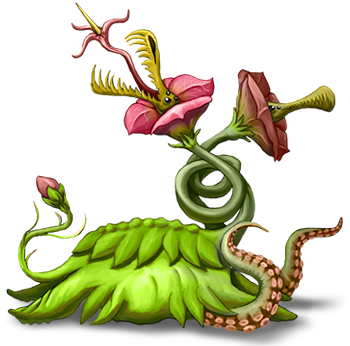 Normal
Normal
 Guardian
Guardian
Species-specific abilities
- Poison
- Acid Strike
- Petrify
- Regeneration
Where the ground churns underfoot with mud and marsh, brilliantly colored flowers protrude from the soil. At first glance it is nothing but that - a flower. However, if one allows themselves to be drawn in by the vivid color or the tantalizing smell wafting on the air, they may feel a stinging pain. The tiny black beads resembling beetles shimmer and twitch - eyes. As the poison begins to settle in, so does realization.
You've stumbled upon a Hydra.
An early experiment by Mages who wished to provide protection for elaborate gardens, Hydras were meant to blend in with their surroundings but exist as a threat at the same time. However, the creatures proved more hostile than originally planned and made no distinction between friend and foe while at the same time taking over the gardens they were meant to protect. Over time they migrated to the marshes and swamps, making use of prehensile tentacles to move across the ground by seizing roots and other plants to pull themselves along or propel through the water if needed.
By use of mildly toxic venom, Hydras will paralyze their prey and feed, using quick-working acids to break down their meals. While they can be disabled momentarily by pinning them to the ground or chopping off their heads, they boast remarkable regenerative abilities. This is even further enhanced within the Vermilion strain, who are more easily spotted due to the purple coloring along their backs, which appear mossy in nature. The Vermilion strain sports venom with a higher toxicity, something that seems to have affected the flowering area as well, leaving it looking slightly wilted and yellow-brown in coloration.
The only true solution seems to be burning them, a difficult task due to their damp environment. For the most part they should be avoided, for while they shouldn’t be typically fatal unless engaged they may prove a danger. If bitten, Hydra venom in a single dose typically sets in within minutes, leaving small creatures completely paralyzed and larger specimens with numb sensations and difficulty moving. Hydras employ the use of venom and violent puncturing attacks with a spine on what the casual observer may deem a 'tongue'.
To spot a Hydra from a distance, one may simply examine a patch of flowers. While clever mimics, Hydras fail to 'wave' in a breeze, remaining fairly still even in a storm. They have also been known to chatter as small rodents do, perhaps an attempt to draw them in. Whether their vocal mimic abilities extend past this is unknown.
If bitten, one should attempt to remove the venom by any means necessary, clean the surrounding area, and get out of the Hydra's range to keep from enduring further damage.
Hopper
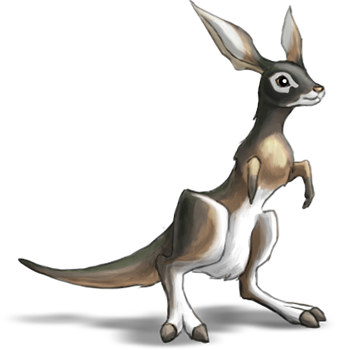
Species-specific abilities
None
It took several moments to realize how eerily quiet it was. While it was the plains rather than the forest, there still should have been birds, insects. Something should have been making sound. Hesitantly, you move forward on the dirt trail, when all at once you realize it's not the caffeine buzz that is making your feet vibrate. The ground is shaking. All at once, half a dozen creatures clear the ridge, quickly followed by even more of them. They move almost too fast, but eventually you take in features - large, powerful legs, a set of over-sized ears, and bright yet dark eyes that are wide in fright. One of them hits you in its scramble to escape, knocking you flat on your back with those huge paws. A moment later, something wings overhead with a roar, chasing after its prey.
For most of the time, Hoppers prove extremely peaceful creatures. Resembling the Kangaroos of Earth in their general shape, their most noted feature are the large, powerful hind legs. Using these strong legs, hoppers move with ease across the plains they call home. They can also sprint, using strengthened leg muscles to propel them across flat lands at high speeds. They are popular hunting objectives, due to their soft hide that proves to create durable leather for clothing, armor and even pet tack. Their meat is considered a delicacy in many territories, and meals composed of Hopper steaks often take center stage at a feast or festival.
Unsuitable as pets due to their avoiding nature, Hoppers are best viewed at a distance. While intelligent enough to know when they’ll lose a fight (resulting in their rapid departure from the area), Hoppers will attack almost anything save other Hoppers with harsh kicks known to cave in a chest cavity. They prove highly sensitive to their environment, and as a result domestication of Hoppers have proved a failure. Disturbed by the unnatural surroundings in captive locations, Hoppers refuse to breed, and typically die within days due to anxiety. However, locals still attempt, sedating wild Hoppers with potent tranquilizers before returning to home base. All attempts at securing a pregnant Hopper proved unsuccessful, and it is suspected that Hoppers with babies (hoplings) lay low in a den for some time. Hoppers typically only have 1-2 offspring at a time, and just hours after being born hoplings take their first steps. Much smaller than their parents, hoplings take refuge in crevices or the brush when predators are about, although they make easy prey for R’Rakos.
Hoppers boast remarkable eyesight and hearing, and do not base their vision on motion like most creatures, easily spotting even a lurking dragon attempting to remain still and unnoticed. A single twig breaking may send a Hopper running, and as such they are difficult to walk up on. Herds of Hoppers may break into a stampede if threatened, trampling grass (and anyone who gets in the way) in their rush to avoid threats. Herbivores by nature, they are unaffected by most plants of a poisonous nature, but easily avoid anything that may prove dangerous using their keen sense of smell. In this way it is proving difficult to drug Hoppers, as they immediately pick out the foreign scent. If their suspicion is raised, Hoppers may even flee or become aggressive. It is highly suggested to hunt Hoppers using long-range weapons, as well as to take your time; if you miss, say goodbye to the entire herd.
Desert monsters
R'Rakos
Morphs
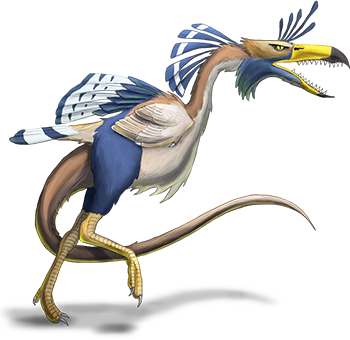 Normal
Normal
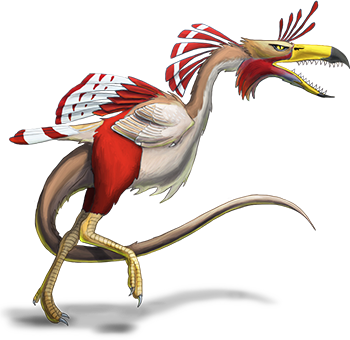 Guardian
Guardian
Species-specific abilities
- Shriek
- Berserker
- Second breath
From a distance it’s almost something you’d laugh at. The head bobs as it walks, and that tail is constantly moving and lashing from side to side. Brightly colored feathers seem to shudder as it moves, the coloration making it easy to spot on the dusty terrain. For once, you’ve spotted a monster from a distance, and it’s stalking something besides you. With jerky movements that remind you of a domestic chicken, it trots across the cracked earth before pouncing. A long, dark-tipped beak jerks forward and digs into the crevices before snapping back, a writhing serpent gripped in its beak. After dispatching the snake, the creature shifts its attention, letting out an eerie cry.
To your horror, there is an answering cry from just yards behind you.
Flightless birds of a great size, R'Rakos are to be left to themselves. Believed to be distant relatives to the vicious Cockatrice, they highly resemble ancient reptiles, leading scientists to classify them as such rather than as birds. Along with their heavy skull, tooth jaws and three-chambered heart, R'Rakos also have asymphtous vertebrae, allowing their long tails to be almost elastic. Despite how bizarrely these creatures move, they are quite nimble and dexterous, capable of grabbing things with their feet and beak to tear at or just simply carry.
Carnivorous in nature, R'Rakos aren't picky in the slightest, feeding on anything they may find in their arid homes. Snakes, scorpions - even giant centipedes aren't off the list, as well as many other dangerous even deadly animals avoided by other predators. While fierce hunters, R'Rakos aren't above scavenging or even stealing prey from other predators. This is unsurprising, as most prey is difficult to locate in the desert heat, yet a family of R'Rakos will even take on dragons if the food is promising.
R'Rakos use their entire bodies when communicating, but feathers play a vital role in this system. Using their spine and neck feathers, R'rakos may appear much larger than initially, allowing them to frighten off opponents without even beginning the fight. When feeling a particularly intense emotion - excitement, fear or anger - the R'Rakos will bristle all its feathers, spreading its wings and extending its neck to appear as impressive as possible. Subtle jerks of the head and flashing of feathers are used to communicate between family members, as well as the motion of their talons. R'Rakos are capable pack hunters, communicating with their feathers and small body motions to indicate their decisions - be it to forge ahead, or to back off and look for food elsewhere.
As frightening as these creatures may be, they have an outstanding family behavior. Nests typically produce two to four hatchlings, and while R'Rakos are fairly capable within two years, parents continue to protect, feed and teach their children for an additional year. At three years old, R'Rakos are fully mature, and this behavior ensures an 80% chance of survival for chicks. Yet even after a R'Rakos is fully grown it may remain with its parents, hunting alongside them in a unit.
Cryptomorph
Morphs
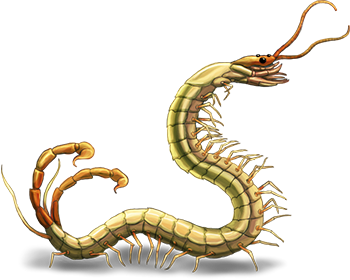 Normal
Normal
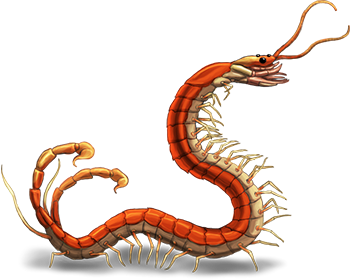 Guardian
Guardian
Species-specific abilities
None
The caves allegedly go on for miles, and the rivers that formed them have long since vanished. Yet, there are some signs of life - scratches on the rocks, scraps of fur and feathers. You take a few more steps, your flashlight breaking through the darkness. Something rustles and you shift your gaze. The tail of a scorpion is just visible behind a rock. It doesn’t look that big, but you’d rather not take your chances. You manage half a dozen steps before hearing that rustling sound again, and something slithers across your path, hissing like some sort of over-sized snake; but the creature is no serpent. It looks like something from a nightmare. Resembling a giant centipede with the tails of a scorpion, it rises up on its legs and lets out another of those terrifying hisses.
You’ve got to stop going on these ventures alone.
Growing up to four meters in length, Cryptomorphs highly resemble the centipedes of Terra. The most noticeable difference of course is their tail, or well, tails. Roughly a foot in length, these barbed tails resemble that of a scorpions, and are just as dangerous. Proving highly venomous both from the tail and the bites produced by its powerful jaws, it is advised to avoid Cryptomorphs at all costs. While nocturnal in nature, Cryptomorphs are happy to wake up and leave their beds for a quick meal if disturbed.
Due to a poor ability to regulate water in their system, these creatures have a very cryptic lifestyle. In dry conditions they lose water bizarrely fast, and as such their behavioral patterns have adjusted to avoiding long stays on the surface during the day. While capable of digging a hideaway, Cryptomorphs are frequently found under logs or large stones, as well as within caves. Even an abandoned pile of debris can be home to one of these creatures, and abandoned structures can end up with quite the infestation. If one is unable to avoid common hiding places for Cryptomorphs, we remind you that these fast and fierce creatures do fortunately have a primitive brain. Their vision is movement based, and their sense of smell is almost nonexistent.
The easiest way to incapacitate one is to severe the head, or at least drop something heavy on it. However, due to a delayed nervous system, it is advised to avoid the tail end when doing so. Even after death the body may continue to move and strike, and others have seen the jaws on a Cryptomorph’s severed head continue to snap, latching onto anyone nearby. Of course, shortly after the creature’s nervous system shuts down, making it painfully difficult to remove the jaws from your ankles …
Surprisingly, Cryptomorphs are considered to be a delicious meal, their meat resembling in taste something like a deepwater crustacean. Still, it is advised to remove the legs before serving, as they are virtually without meat and unappealing in appearance. Their natural enemies are the giant chimeric creatures known as R’Rakos. While typically hunting in packs, R’Rakos can handle these arthropods safely alone. Just behind the head of a Cryptomorph are a series of neural chains, and when broken are the quickest way to kill a Cryptomorph. However, those without a long neck and powerful beak may find this difficult.
Dangerous, lethal creatures, they are best avoided by even the hardiest of travelers.
Quezal
Morphs
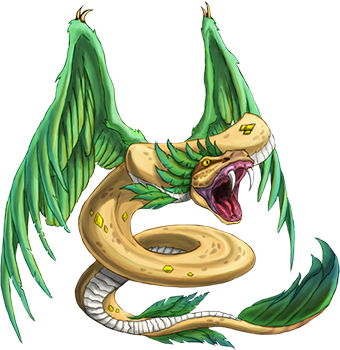 Normal
Normal
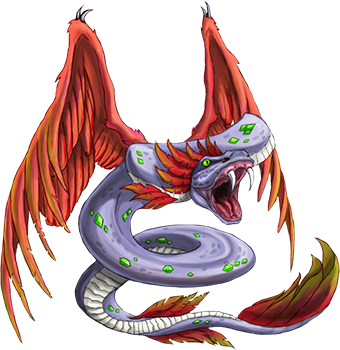 Guardian
Guardian
Species-specific abilities
- Poison
- Acid Strike
- Petrify
- Regeneration
For the third time that evening, your light glints off something among the brush. Puzzled, you approached it only to find nothing. At least, the first time. The second time there was a soft rustling sound, only noticeable between the outbursts from the birds fluttering through the treetops. The last time, however, you’re determined to find it. As soon as you spot it, you fling yourself forward, brushing aside the dew-laden leaves of a fern.
From under a nearby log, a root sticks out, glittering strangely. It takes you several moments to realize there are gems embedded within. At least, it sure looks like gems. Puzzled, you lean down for a closer look, only to realize the bizarre thing isn’t a root. It’s a tail.
A moment later, there is an explosive hiss. In a flash of color, feathers and scales, a winged serpent throws itself into the air. It takes you a moment to categorize the thing - a Quezal.
Roughly classified in the same category as the Cockatrice and the R'Rakos, there is one major difference. Over time, the Quezal's legs developed into functional wings, allowing this serpent-like creature to take flight with ease. They're known to drop from the tree tops and glide across the terrain, using their lengthy body to throw themselves into the air. For the most part, Quezal are found within tropical forests, although more and more they have been spotted in more arid regions.
Measuring between eight and fifteen feet in length, Quezals are venomous reptiles that typically feed on small animals. Larger animals can be difficult to surprise and take down in the jungle, but a hungry Quezal is known to even try its luck with Unicons if the opportunity arises. Surprisingly, Quezals prove to be dangerous or aggressive only when hungry, or towards a direct threat. Otherwise, they tend to slither into the undergrowth or take flight, avoiding the potential conflict as best they can.
Outside their vividly colored feathers, Quezals hold other birdlike habits. Some are known to create nests under bushes or in tree tops, and they have a bizarre collecting habit. Like a magpie, Quezals will search out and collect precious stones - or anything that shines, but gemstones themselves seem to be the most popular. Decorating both their nests and their skin with these gems, the habit has no logical explanation. Scientists and biologists alike have found no role for the gem decorating in the biology or ecology of the Quezals.
Instead, many believe this behavior stems from a practice of their ancestors, where the jewels were a part of a courtship ritual. The number of jewels as well as the size of the feather crown can tell how old an animal is, as well as how skilled. It is common practice to hunt Quezals down for their jewels and feathers, which are used in decorative pieces for the aristocrats. Legends also circulate that the jewels of Quezal may carry magical properties. While those of magical inclination have found little in the way of special properties, many did detect an unusual spectrum. This appears, likely, due to the chemical reactions caused by contact with a live body. It is unknown exactly how Quezals manage to keep these jewels attached to their skin.

